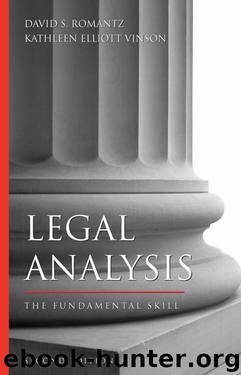Legal Analysis by David S. Romantz & Kathleen Elliott Vinson

Author:David S. Romantz & Kathleen Elliott Vinson
Language: eng
Format: mobi
Tags: Legal Practical Resources, Pre-Law, Introduction to Law, Law School Study Aids, Lawyering Skills/Study Aids
Publisher: Carolina Academic Press
Published: 2009-06-30T21:00:00+00:00
Resolved Ambiguity: Congress intended the word “uses” to mean engaging or firing a gun in the commission of the crime.
Minor Premise: The defendant bartered a gun for five kilograms of cocaine.
Conclusion: The defendant shall not be sentenced to prison under the statute.
Both the government and the defendant resolved the ambiguity by offering a definition that defines the term “uses.” Each party advanced a definition that benefited his or her legal position. Both parties then employed deductive or rule-based reasoning and deduced a conclusion by applying the minor premise—the facts—to the resolved major premise—the statute. Because each argument rested on the resolution of the ambiguity in the major premise, each party is able to deduce a conclusion that favors his or her position. Ultimately, the prevailing party is the one who presents the more credible or “truthful” resolution of the ambiguous term.
Download
This site does not store any files on its server. We only index and link to content provided by other sites. Please contact the content providers to delete copyright contents if any and email us, we'll remove relevant links or contents immediately.
| Annotations & Citations | Law School Guides |
| Legal Profession | Legal Writing |
| Test Preparation |
Master of the Game by Sidney Sheldon(2209)
GRE Premier 2017 with 6 Practice Tests by Kaplan(1783)
Law School Essays that Made a Difference by Princeton Review(1740)
Law: A Very Short Introduction by Raymond Wacks(1664)
A Life of Crime by Harry Ognall(1620)
Objection! by Nancy Grace(1599)
Philosophy of law a very short introduction by Raymond Wacks(1581)
Examples & Explanations: Administrative Law by William F. Funk & Richard H. Seamon(1579)
College Essays that Made a Difference by Princeton Review(1575)
Writing to Win: The Legal Writer by Steven D. Stark(1517)
Cracking the SAT Premium Edition with 6 Practice Tests, 2017 by Princeton Review(1509)
GMAT For Dummies by Lisa Zimmer Hatch & Scott A. Hatch(1467)
Civil Procedure (Aspen Casebooks) by Stephen C. Yeazell(1463)
Sidney Sheldon (1982) Master Of The Game by Sidney Sheldon(1449)
Drafting Contracts: How and Why Lawyers Do What They Do, Second Edition by Stark Tina L(1429)
Storytelling for Lawyers by Meyer Philip(1382)
So You Want to be a Lawyer by Lisa Fairchild Jones Esq(1355)
Graduate Admissions Essays, Fourth Edition: Write Your Way into the Graduate School of Your Choice by Donald Asher(1332)
INDEFENSIBLE: One Lawyer's Journey Into the Inferno of American Justice by Feige David(1212)
